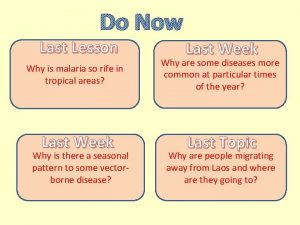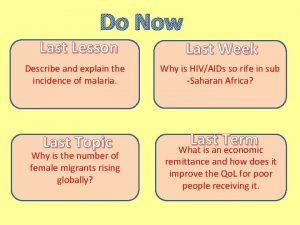Do Now Last Lesson Last Week What are











- Slides: 11

Do Now Last Lesson Last Week What are the 4 ways in which disease can diffuse? What has enabled pandemics to spread so oquickly? Last Topic Last Term What economic and social What is a social remittance and how can lead to development? opportunities are created through migration? Support with examples.

Learning Objectives: q To analyse the factors that help spread/diffuse disease. q To analyse the factors that contain the spread of disease (reduce diffusion). We call these barriers to diffusion.

Factors that help spread disease These tend to be socio-economic factors o Crowded living + working conditions o Inadequate sanitation o Unclean water supplies o Inadequate nutrition - too little or too much! o Low income - no medical help, no resources [e. g. soap/household cleaners, mosquito net/repellent, antiseptic cream etc. o Long working hours o Physically exhausting work o Lack of or inaccessible health care o Inadequate education, e. g. HIV/AIDS sufferers not understanding the concept of safe sex

Factors that have limited the reduction in incidence of disease • Social stigma e. g. HIV/AIDs ‘gay disease’ e. g. USA 1970/80 s, Russia now. • Culture/religion e. g. AIDs and denial in Sub-Saharan Africa. • Multiple use of water source e. g. washing, cooking, sewerage, garbage diarrhea. • Cost e. g. TB vaccination. • Poverty/inequality e. g. lack of access to health care, overcrowding, lack of clean water + sanitation. • Poor education. • Low status of women [why might this is a factor? ]. • Globalisation: – Increased air travel – Livestock transportation via road/rail/boat

WHY ARE DISEASES SPREAD? o There a whole range of social, physical, political and socio-economic reasons/factors that encourage the diffusion of disease (see previous slides) o BUT … there also “Barriers to Diffusion” which limit the spread of disease. o These barriers can be physical or socio-economic.

Barriers to Diffusion o Can you think of any physical barriers which may slow or halt diffusion? ü ü ü Mountain ranges. Seas or oceans. Deserts. Climate (extreme cold temperatures). Remoteness. Distance.

Barriers to Diffusion § The incidence of a disease is likely to be affected by distance. § Places closer to the source (of disease) are more likely to see a higher incidence. § Areas further away from the source are less likely to be affected and/or will be affected at a later date. Incidence of disease X o The most important physical barrier is distance. o The probability of a contagious disease spreading to an area is inversely proportional to distance from its source. o This is called “Distance Decay”. Distance from source of disease

Barriers to Diffusion Political factors (work to limit rate and spread of disease). • National policies made by the government to restrict the travel of people via international airports. Or by training medical personnel. Ebola 2014. Travel restrictions/migration control and screening of travelers can form ‘human’ barriers [health monitoring + borders can be closed]. • Lockdown in UK 2020 –> Covid-19. Imposing curfews to limit contact between people. E. g. Sierra Leone in 2015 in an effort to contain the Ebola virus. Sending AID e. g. Haiti earthquake 2010. Forward thinking governments making commitments and providing funding to tackle pandemics like HIV/AIDS Ugandan government tackling HIV.

Barriers to Diffusion Political factors (work to limit rate and spread of disease). Public health education/advice: heightened awareness of hygiene e. g. hand washing/safe sex advice/face masks/free needles for drug addicts Wearing face masks in places and cancelling public events. Mass vaccination programmes to protect populations against diseases like flu and health education. • Quarantine [Western aid workers returning from Ebola work in W Africa].

Socio-economic barriers include: ü Global mobility - Improved transport and communications linked to globalisation e. g. bigger aeroplanes; faster and more widespread rail and road networks has improved the ability of international Aid agencies and NGOs to respond quickly and efficiently to disease crisis areas. E. g. Cholera Haiti 2010 or Ebola 2014. e. g. Covid- 19 2020 ü Technology - Linked to level of economic development and ability to invest resources into disease detection; monitoring; treatment and mitigation. In ACs, the resources are available to invest in screening; ultra-sound scans; keyhole surgery etc. UK – blood screening for HIV; screening and ultra-sounds to detect cancers; key hole surgery to remove tumours or do heart surgery to reduce CHD. Vehicles to transport vaccines and medicines have become far more sophisticated and hi-tech e. g. refrigerated containers/lorries to transport medicines and vaccines.

Other socio-economic barriers include: ü Education - the WHO and Red Cross seek to educate people about how diseases are caught; transmitted and how they can be mitigated against. Particularly successful at grass roots level. Guinea Worm in Ghana. At national level, also successful. ABC programme in Uganda to educate public about HIV/AIDS and cancer awareness in UK and obesity in UK, Brazil and China.
 Antigentest åre
Antigentest åre Last week's lesson
Last week's lesson Week by week plans for documenting children's development
Week by week plans for documenting children's development Now upon the first day of the week
Now upon the first day of the week Now i see it now you don't
Now i see it now you don't Where were you last weekend?
Where were you last weekend? What did you do last saturday
What did you do last saturday The kind has broken the window
The kind has broken the window They ... a football yesterday
They ... a football yesterday Writing about my friend birthday party
Writing about my friend birthday party What was the weather like last week
What was the weather like last week Homework-finish-your-tomorrow
Homework-finish-your-tomorrow





















